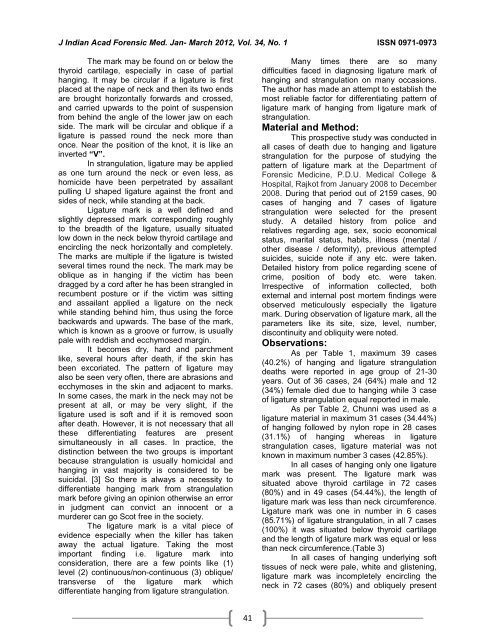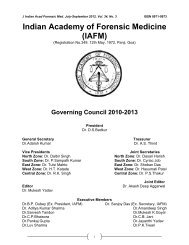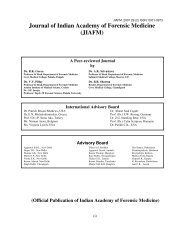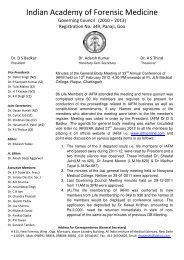Indian Academy of Forensic Medicine (IAFM) - Official website of IAFM
Indian Academy of Forensic Medicine (IAFM) - Official website of IAFM
Indian Academy of Forensic Medicine (IAFM) - Official website of IAFM
You also want an ePaper? Increase the reach of your titles
YUMPU automatically turns print PDFs into web optimized ePapers that Google loves.
J <strong>Indian</strong> Acad <strong>Forensic</strong> Med. Jan- March 2012, Vol. 34, No. 1 ISSN 0971-0973<br />
The mark may be found on or below the<br />
thyroid cartilage, especially in case <strong>of</strong> partial<br />
hanging. It may be circular if a ligature is first<br />
placed at the nape <strong>of</strong> neck and then its two ends<br />
are brought horizontally forwards and crossed,<br />
and carried upwards to the point <strong>of</strong> suspension<br />
from behind the angle <strong>of</strong> the lower jaw on each<br />
side. The mark will be circular and oblique if a<br />
ligature is passed round the neck more than<br />
once. Near the position <strong>of</strong> the knot, it is like an<br />
inverted “V”.<br />
In strangulation, ligature may be applied<br />
as one turn around the neck or even less, as<br />
homicide have been perpetrated by assailant<br />
pulling U shaped ligature against the front and<br />
sides <strong>of</strong> neck, while standing at the back.<br />
Ligature mark is a well defined and<br />
slightly depressed mark corresponding roughly<br />
to the breadth <strong>of</strong> the ligature, usually situated<br />
low down in the neck below thyroid cartilage and<br />
encircling the neck horizontally and completely.<br />
The marks are multiple if the ligature is twisted<br />
several times round the neck. The mark may be<br />
oblique as in hanging if the victim has been<br />
dragged by a cord after he has been strangled in<br />
recumbent posture or if the victim was sitting<br />
and assailant applied a ligature on the neck<br />
while standing behind him, thus using the force<br />
backwards and upwards. The base <strong>of</strong> the mark,<br />
which is known as a groove or furrow, is usually<br />
pale with reddish and ecchymosed margin.<br />
It becomes dry, hard and parchment<br />
like, several hours after death, if the skin has<br />
been excoriated. The pattern <strong>of</strong> ligature may<br />
also be seen very <strong>of</strong>ten, there are abrasions and<br />
ecchymoses in the skin and adjacent to marks.<br />
In some cases, the mark in the neck may not be<br />
present at all, or may be very slight, if the<br />
ligature used is s<strong>of</strong>t and if it is removed soon<br />
after death. However, it is not necessary that all<br />
these differentiating features are present<br />
simultaneously in all cases. In practice, the<br />
distinction between the two groups is important<br />
because strangulation is usually homicidal and<br />
hanging in vast majority is considered to be<br />
suicidal. [3] So there is always a necessity to<br />
differentiate hanging mark from strangulation<br />
mark before giving an opinion otherwise an error<br />
in judgment can convict an innocent or a<br />
murderer can go Scot free in the society.<br />
The ligature mark is a vital piece <strong>of</strong><br />
evidence especially when the killer has taken<br />
away the actual ligature. Taking the most<br />
important finding i.e. ligature mark into<br />
consideration, there are a few points like (1)<br />
level (2) continuous/non-continuous (3) oblique/<br />
transverse <strong>of</strong> the ligature mark which<br />
differentiate hanging from ligature strangulation.<br />
41<br />
Many times there are so many<br />
difficulties faced in diagnosing ligature mark <strong>of</strong><br />
hanging and strangulation on many occasions.<br />
The author has made an attempt to establish the<br />
most reliable factor for differentiating pattern <strong>of</strong><br />
ligature mark <strong>of</strong> hanging from ligature mark <strong>of</strong><br />
strangulation.<br />
Material and Method:<br />
This prospective study was conducted in<br />
all cases <strong>of</strong> death due to hanging and ligature<br />
strangulation for the purpose <strong>of</strong> studying the<br />
pattern <strong>of</strong> ligature mark at the Department <strong>of</strong><br />
<strong>Forensic</strong> <strong>Medicine</strong>, P.D.U. Medical College &<br />
Hospital, Rajkot from January 2008 to December<br />
2008. During that period out <strong>of</strong> 2159 cases, 90<br />
cases <strong>of</strong> hanging and 7 cases <strong>of</strong> ligature<br />
strangulation were selected for the present<br />
study. A detailed history from police and<br />
relatives regarding age, sex, socio economical<br />
status, marital status, habits, illness (mental /<br />
other disease / deformity), previous attempted<br />
suicides, suicide note if any etc. were taken.<br />
Detailed history from police regarding scene <strong>of</strong><br />
crime, position <strong>of</strong> body etc. were taken.<br />
Irrespective <strong>of</strong> information collected, both<br />
external and internal post mortem findings were<br />
observed meticulously especially the ligature<br />
mark. During observation <strong>of</strong> ligature mark, all the<br />
parameters like its site, size, level, number,<br />
discontinuity and obliquity were noted.<br />
Observations:<br />
As per Table 1, maximum 39 cases<br />
(40.2%) <strong>of</strong> hanging and ligature strangulation<br />
deaths were reported in age group <strong>of</strong> 21-30<br />
years. Out <strong>of</strong> 36 cases, 24 (64%) male and 12<br />
(34%) female died due to hanging while 3 case<br />
<strong>of</strong> ligature strangulation equal reported in male.<br />
As per Table 2, Chunni was used as a<br />
ligature material in maximum 31 cases (34.44%)<br />
<strong>of</strong> hanging followed by nylon rope in 28 cases<br />
(31.1%) <strong>of</strong> hanging whereas in ligature<br />
strangulation cases, ligature material was not<br />
known in maximum number 3 cases (42.85%).<br />
In all cases <strong>of</strong> hanging only one ligature<br />
mark was present. The ligature mark was<br />
situated above thyroid cartilage in 72 cases<br />
(80%) and in 49 cases (54.44%), the length <strong>of</strong><br />
ligature mark was less than neck circumference.<br />
Ligature mark was one in number in 6 cases<br />
(85.71%) <strong>of</strong> ligature strangulation, in all 7 cases<br />
(100%) it was situated below thyroid cartilage<br />
and the length <strong>of</strong> ligature mark was equal or less<br />
than neck circumference.(Table 3)<br />
In all cases <strong>of</strong> hanging underlying s<strong>of</strong>t<br />
tissues <strong>of</strong> neck were pale, white and glistening,<br />
ligature mark was incompletely encircling the<br />
neck in 72 cases (80%) and obliquely present









